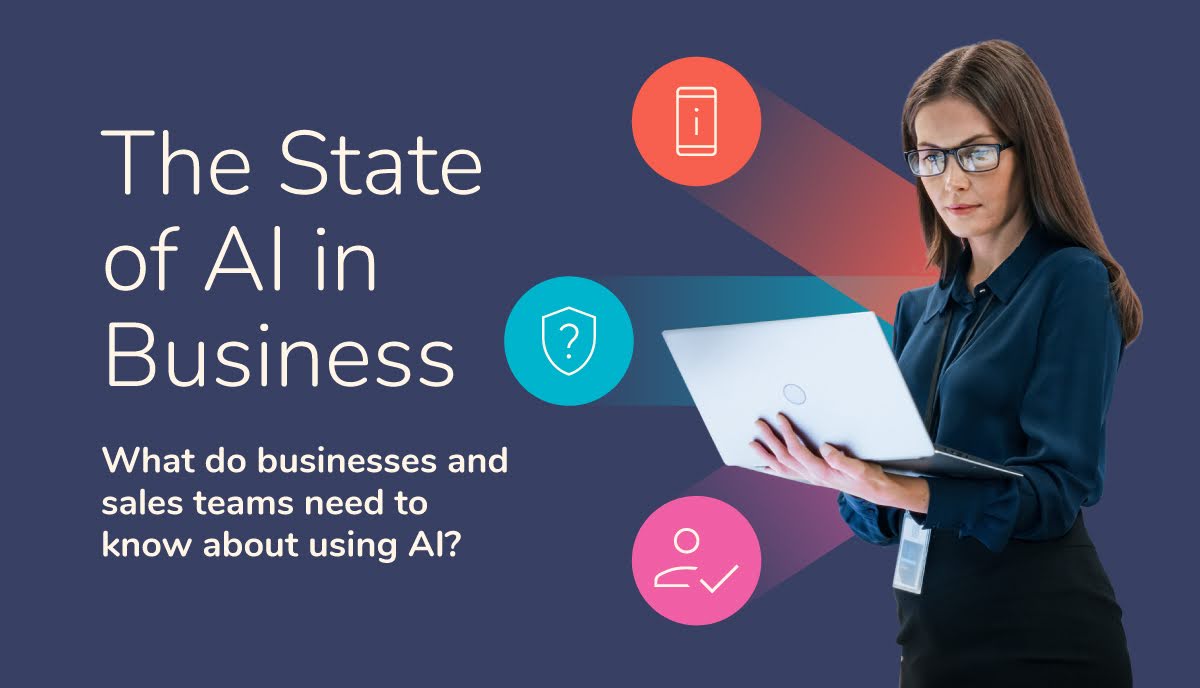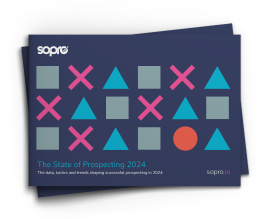The state of ai in business
In this blog
- Awareness and understanding of AI
- Impact and personal use
- Benefits and risks of AI
- AI in the workplace
- Ways business owners use AI
- Ways AI is improving the customer experience
- Internal processes business owners use AI to improve
- Positive impacts business owners expect from AI
- Which job roles use AI the most?
- Which industries use AI the most?
- How are businesses using AI to aid personalisation?
- Methodology
The state of AI in business

What do businesses and sales teams need to know about using AI?
Artificial Intelligence (AI) is transforming the business landscape across various industries, offering unprecedented innovation and customer service improvements, including in prospecting.
AI technologies are reshaping how companies identify and engage with potential customers, offering solutions that enhance efficiency and effectiveness. However, there are concerns about AI and how businesses and consumers will use it.
Recent reports show that ‘human’ interaction with customers needs to be one of businesses’ biggest priorities in 2024, as almost half (47%) of UK consumers are concerned about the takeover of AI. So, what do businesses need to consider when utilising AI?
To help, the business sales experts at Sopro take a detailed look at how AI is shaping the business world and customer interactions, and offer their tips on how businesses can use AI to drive sales without alienating customers.
What are people’s opinions about AI?
Awareness and understanding of AI
In an ONS survey, the majority of respondents (72%) had heard of AI, with around 1 in 5 (19%) able to explain it in detail. This suggests a general awareness of AI, though the depth of understanding varies.
Younger individuals (16-29) are more likely to have heard of AI (93%) and can explain it in some (or complete) detail (78%). Whereas, a significant portion (43%) of the oldest generation (70+) had either never heard of AI or could not explain what it is.
According to the survey, only 17% of Brits often or always recognise when they’re using AI. This shows a significant gap in the public’s ability to identify the new technology, which could affect their understanding of its impact.
London has the highest percentage of respondents who recognise AI usage (20%), while Wales has the lowest (14%). This is likely due to more people in the capital working in tech-focused roles than rural Wales.
Impact and personal use
*Among those who reported using Artificial Intelligence (AI) chatbots in the past month.
Younger people (16-29) show higher engagement with AI technologies, with 42% using AI chatbots in the past month, compared to 9% of those aged 70 and older.
One-third of the survey respondents have used AI chatbots. Of these, they are used mainly for customer service (50%) and just to try them out (33%).
Other significant uses include entertainment, seeking advice (19%) and work-related tasks (18%), highlighting the diverse ways chatbots are used in everyday life.
However, many simply aren’t engaged with AI at all. Half (50%) of the population has not used AI intentionally in their day-to-day lives, suggesting they don’t need it or that AI technologies aren’t accessible enough.
Benefits and risks of AI
There’s a fairly balanced view on the benefits and risks of AI, with 43% believing they are equal. However, more respondents believe there are more risks (28%) than those who see more benefits (14%).
The main concerns about AI are the misuse of personal data (72%) and the difficulty distinguishing fake news (68%), which show significant fears about privacy and whether AI can be trusted.
Across the UK, concerns about AI’s misuse of personal data and increasing cybercrime are prevalent, with the South East in particular showing deep concern about fake news (72%).
Younger people tend to see AI as a tool for enhancing learning, improving job prospects, and streamlining tasks. In contrast, older individuals recognise some benefits, such as improved healthcare access, but remain sceptical about AI’s overall role in their lives, including on their employment and income.
AI in the workplace
A substantial majority (69%) believe employers should consult employees before introducing AI technologies, showing the importance of including employees in decisions that impact their work environment and fully explaining the benefits to them.
Across all regions of the country, most believe humans should make the final decisions in hiring (88%), performance management (83%), and firing (90%), over AI.
How do businesses use AI?
The integration of AI in the business landscape is transforming how companies operate, interact with customers, and manage their internal processes. But how exactly are business owners using AI, and what are the benefits?
Ways business owners use AI
1. Customer service: AI is most commonly used to enhance customer service through automated responses and chatbots that can handle inquiries 24/7, improving customer engagement and satisfaction.
2. Cybersecurity/fraud management: Over half of business owners use AI tools to bolster cybersecurity measures and manage fraud. These tools can analyse patterns and identify potential threats more efficiently than traditional methods.
3. Digital personal assistants: 47% use AI-powered assistants to help streamline daily tasks, schedule meetings, and manage emails, which increases productivity.
Ways AI is improving the customer experience
1. Instant messaging: Chatbots are the leading form of AI that improves customer service, with around three-quarters using them. These offer instant responses to customer queries, making them a valuable tool.
2. Emails: AI tools can also automate and personalise email communications, improving customer engagement. Just over 3 in 5 businesses use AI for their emails.
3. Personalised services: Including tailored product recommendations significantly enhances the shopping experience for customers.
Internal processes business owners use AI to improve
1. Production processes: 53% of business owners use AI to improve their production processes. AI can help improve the efficiency and quality of production lines, especially in manufacturing businesses.
2. SEO tasks: Narrowly behind with 52%, AI tools can also assist in keyword research and SEO optimisation, enhancing the business’ online visibility.
3. Process automation: Just over half of business owners use AI to automate routine and repetitive tasks through AI, freeing up human resources for more complex tasks.
Positive impacts business owners expect from AI
1. Improving customer relationships & increasing productivity: These two impacts are tied for first place, with just under two-thirds of business owners highlighting them. This shows how important AI is in fostering business growth, efficiency and customer relations.
3. Increasing sales: 3 in 5 business owners believe that AI can help them to increase sales. AI-driven insights and automation can directly contribute to increased sales figures.
Which job roles use AI the most?
More senior job roles tend to use AI more, with 15% of C-level executives using it, almost double that of mid-level managers. This could be due to greater access to technology or the fact that they’re more involved in strategy.
The lower engagement of mid-level managers could suggest barriers, such as less access to advanced technologies or a feeling that they don’t need to use them.
Senior managers are most likely to use AI in personal and professional settings, with 28% doing so, compared to 26% of C-level execs and 24% of mid-level managers.
However, employees across all levels have many people experimenting with AI at least once, showing a general curiosity and openness to AI.
Which industries use AI the most?
1. Business, legal and professional services
This sector leads the way in both work-related (19%) and combined work and non-work-related (38%) use of AI. This shows how it integrates into core activities for these businesses, like data analysis, automation of routine tasks, and customer relationship management.
2. Media and telecom
Two industries are tied for second place, with 15% using AI regularly at work, the first of which is media and telecom. This sector uses AI to improve content personalisation, optimise media distribution, and improve customer service through chatbots and automated systems.
2. Technology
15% of people also regularly use AI at work in the tech sector. Understandably, this sector is a big adopter of AI, with it playing a significant role in developing new tech products and services and generally being a considerable influence in the industry.
How are businesses using AI to aid personalisation?
A substantial 92% of companies use AI-driven personalisation as a key strategy to drive their business growth, which shows how vital tailoring experience is to individual customer preferences. AI can help facilitate this by analysing large datasets to predict and respond to customer needs.
However, despite the enthusiasm among businesses, consumer reception could be improved. Only 41% of consumers are comfortable with AI being used to personalise their experiences. This shows a potential gap between AI’s value to businesses and customers’ trust and understanding of the technology.
From the perspective of business leaders, 62% have seen improved customer retention due to personalisation efforts. This shows the benefits of fostering customer loyalty and engagement and how this can improve revenue.
When it comes to measuring the success of AI-driven personalisation, data accuracy is the primary concern. 47% highlighted this, showing how important it is that AI algorithms are fed by precise and reliable data. 44% of businesses consider the speed of real-time data processing crucial, allowing them to offer timely and relevant personalisation.
The same percentage also tracks customer retention or repeat purchases to assess the impact of their personalisation strategies, reinforcing the link between customised experiences and customer loyalty. 42% of companies value the time-saving aspects of AI personalisation.
Rob Harlow, Chief Innovation Officer at Sopro, offers his insights into the benefits of incorporating AI in business and prospecting:
“Incorporating artificial intelligence into business and prospecting methods offers excellent potential to improve efficiency, personalisation, and decision-making. However, using AI successfully requires a thoughtful approach to balance its benefits with the risks of it not being used properly or relied on too much.
“An overwhelming majority of AI use cases exist to augment human-based processes and whilst the hyped narrative is how AI is going to steal all of our jobs – I believe we are some way off of that. Here’s how businesses can integrate AI smartly, using prospecting services to ensure that personalisation is genuinely helpful and not intrusive.
Benefits of incorporating AI into business and prospecting
- Improved efficiency and automation: AI can automate repetitive tasks, or act as a great starting point, allowing employees to focus on the more strategic elements of a task. This can lead to better customer service, quicker data processing, and cost savings.
- Improved personalisation: AI can use advanced data analysis to help businesses understand customer preferences and behaviour more granularly. This allows them to deliver tailored content, recommendations, and solutions, improving the customer experience and boosting loyalty and sales.
- Better decision-making: AI’s ability to process and analyse vast amounts of data can help businesses make informed decisions quickly. This is has typically particularly beneficial in large companies looking at market analysis, financial forecasting, and allocating resources, however the increasing accessibility of this technology makes it something that even the smallest companies can start to benefit from.
Risks & challenges
- Over-personalisation and privacy concerns: While personalisation can improve customer experience, excessive use can lead to privacy concerns and make customers uneasy. Businesses must be transparent about data use and comply with data protection regulations.
- Dependence on AI and losing the human touch: Over-reliance on AI (and particularly the dataset within a large language model (LLM)) can risk losing the nuance of human interactions. If the AI lacks proper context or emotional intelligence, this can lead to generic or inappropriate content.
- AI bias and ethical issues: AI systems can inadvertently reflect biases in training data, leading to unfair outcomes or decisions. Ensuring AI ethics and fairness is crucial for keeping trust and credibility.
Balancing AI and human personalisation
“To get the most out of AI without alienating customers, businesses should balance digital tools and human insight. Combining the latest technology with real human personalisation is the ideal model. Here’s how you can do this.
- Start with a strategy: Define what you want to achieve with AI, whether improving lead generation, personalising marketing efforts or improving customer service. Make sure the plan aligns with the overall business goals and customer expectations.
- Use AI to enhance, not replace, human interaction: AI can handle data-heavy tasks and initial customer interactions. However, humans should remain in the loop for complex decision-making and deeper customer engagement. This balance ensures efficiency without sacrificing the human touch that customers often value.
- Monitor and tweak AI systems: AI is not a “set and forget” solution. Regularly review and adjust AI systems to respond to new data, changing market conditions, and customer feedback to ensure they stay relevant and effective.
- Educate your audience: Make AI less daunting for your customers by explaining how it works and the benefits it brings. Highlighting cases where AI has added value can shift the perception from seeing AI as a basic or invasive tool to recognising it as a sophisticated and beneficial tool.
“By implementing these strategies, businesses can harness AI’s power to streamline operations and enhance the customer experience through true personalisation. With a considered approach that combines the best of digital and human resources, companies can use AI not just as a tool, but as a means to sustainable growth and customer satisfaction.”
Methodology
Data was taken from the following sources:
Opinions and awareness on AI, split by age: the Office for National Statistics’ Artificial Intelligence (AI) awareness, use and impact data to show people’s.
Public recognition of AI, split by age and region: the Office for National Statistics’ public awareness, opinions and expectations about artificial intelligence data.
Opinions on using AI in the workplace, split by region: YouGov / TUC Survey.
How businesses are using AI, how it improves customer service, how it can improve internal processes, and the positive impact of AI: How Businesses Are Using Artificial Intelligence In 2024 by Forbes Advisor
The percentage of people in different industries using generative AI (and by job title): the state of AI in 2023: Generative AI’s breakout year by Quantum Black AI by McKinsey.
How companies use AI for personalisation: The State of Personalization 2023 by Segment.





